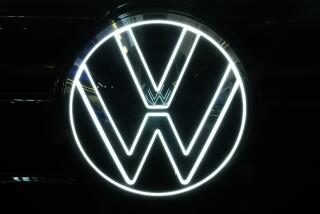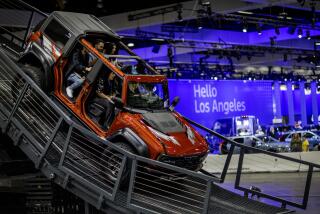2012 Mercedes-Benz CLS 63 AMG: Efficiency and performance in a breathtaking package
When it comes to luxury sport cars, efficiency and performance have been terminally at odds. Twinning the two ideas is akin to pulling together the polarized ends of a magnet. But with its CLS 63 AMG for 2012, Mercedes-Benz has, mein gott, done it.
Not only has Mercedes’ luxury performance car division increased the fuel economy an astounding 32% over the previous version of this svelte, 7-year-old model. (Now, it gets 16 miles per gallon in the city and 21 mpg on the highway.) But the carmarker has also increased its horsepower and torque 2% and 11% respectively, making the heart-pounding performance of this four-door coupe all the more breathtaking.
FOR THE RECORD:
Mercedes-Benz review: A review in the Jan. 27 Business section of the 2012 Mercedes-Benz CLS 63 AMG said fuel efficiency had been improved 32% over the 2011 model. That figure was an estimate from Mercedes-Benz. The Environmental Protection Agency is expected to issue its official federal fuel-efficiency rating for the 2012 model in the spring. —
It’s with a Wizard of Oz sleight of hand that Mercedes’ AMG has pulled this off. Due in June at a price of about $100,000, the new CLS was available for previews last week. That is to say, finished samplers were prepped and readied to chase lesser vehicles off the road.
On a drive through the winding hills of San Diego’s outskirts, its fuel-economy gains were covert — virtually undetectable behind the wheel.
Most of the improvements to this high performer come from stealthy under-the-hood technologies that enabled the monstrous 6.2-liter engine of its predecessor to shrink to a slightly less monstrous 5.5-liter. In its overhaul, the V-8 is equipped with twin turbochargers.
More significantly, it is enhanced with a new fuel injection system that sprays as many as five short bursts of fuel into each cylinder with each combustion cycle, instead of the usual single spurt. In development for three years, these so-called piezo injectors create faster, more fuel-efficient combustion.
These technologically complicated but significant gains are enhanced with a new multiclutch transmission that, as in many modern performance cars, allows drivers to choose between multiple drive modes.
Turning over the ignition, the car defaults to Controlled mode, which actually shuts down the engine to save fuel when the car comes to a complete stop and automatically restarts it as soon as the brake pedal is released.
It’s an unsettling feeling at first to come to a stop and hear the car die. But that sensation is quickly negated when the brake pedal is released and the roar of the quadruple exhaust kicks in, indicating the car is not only alive but ready to roll over whatever has the misfortune of getting in its way.
A technology that could have been dreamed up by an engineer stuck on Interstate 10 during L.A. rush hour, this stop/start technology can improve fuel efficiency by as much as 10% in thick traffic, exactly the opposite of a traditional car that burns through gas in the push-me-pull-you of constant speed-ups and slow-downs.
While the power delivery in Controlled mode feels bridled, it does respond to how the car is being driven. Someone who steps on the gas gingerly will be rewarded with quick and virtually unnoticeable upshifts through its seven-speed automatic transmission. The car settles into its top gear at speeds as low as 30 mph to save gas. More dynamic driving raises the rpms at which the car upshifts, as does each clockwise twist of the drive-mode selector.
Clicking the knurled knob progressively increases the car’s aggressiveness, from rocket-launcher Sport mode to Sport Plus — an even more responsive setting that is AMG’s version of the “11” amplifier setting in “Spinal Tap.”
What’s so wonderful about this car is that the effects of its brute power are so refined. Like any sports car priced at six figures it inspires drivers to careen through corners at speeds that press against the limits of their abilities. Even better, it’s more than capable of holding a line and keeping the car planted.
I have never felt a car steer as precisely or hug the road as effortlessly as this one, outfitted as it is with steel suspension struts on the front axle, air-suspension in the rear and insanely fast electronic damping. There wasn’t an iota of body roll detectable.
As I swung through corners at speeds I’d normally dare only on a motorcycle, electronic bolsters curled in on the sides of the leather seats, as if God himself were reaching into the cabin, keeping me upright. In fact, the seats were more cupping than the cup holders in this car. While the water bottles toppled from side to side, I was propped up schoolmarm-straight when turning.
The model I tested was outfitted with an $8,500 performance package that ekes even more horsepower and torque from its power plant: 550 horses and 590 pound-feet, respectively.
It was also upgraded with lightweight ceramic brakes that increase braking force by transferring heat away from the calipers that put the big squeeze on the rotors for its 19-inch alloy wheels. The extra $12,500 is a bit spendy, but it’s an upgrade that makes the stopping power so instantaneous and forceful that it felt like I was giving myself the Heimlich maneuver.
No barf bag was required upon stopping. Just some deep breathing as the wind rushed out of my lungs, making me feel lightheaded.
There’s a lot more to be lightheaded about with this new CLS. The smell of tanned leather permeates a well-appointed cabin detailed with carbon fiber on the dashboard and door panels and suede along its roof and steering wheel grips. If this car were a coat, I’d want to wear it.
Alas, it is merely a car. But it is a car that captivates both the heart and the mind, catering to passions with underpinnings of practicality.






